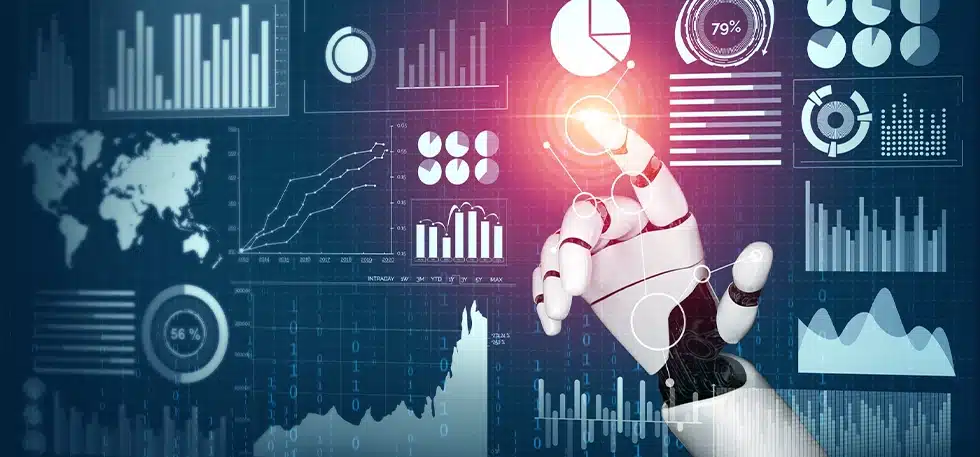Across industries, AI-driven data analytics services is revolutionizing how organizations derive value from their information. From healthcare to finance, logistics to retail, companies are leveraging AI to go beyond static reports—identifying patterns, anticipating trends, and automating decisions in real time. This intelligent approach doesn’t just enhance efficiency; it unlocks entirely new ways to serve customers and optimize operations.
In this blog, we explore how and why AI-driven analytics services has proven to be a game changer for industries.
What is AI-Driven Data Analytics and What Makes It So Powerful?
What makes AI analytics truly transformative is its real-time capability. It continuously ingests and processes streaming data—be it customer clicks on a website, financial transactions, or sensor readings on factory floors—instantly surfacing anomalies, trends, or opportunities. For instance, a fraud detection system can block suspicious activity the moment it’s detected, and a supply chain tool can reroute logistics within seconds of a delay. This immediacy empowers organizations to act not just intelligently—but instantly—where every second counts.
Now, with this evolution, businesses have moved from descriptive to predictive and prescriptive analytics. Instead of asking, “What happened?” companies now ask, “What will happen?” and “What should we do?” AI makes analytics faster, more accurate, and deeply adaptive, powering smarter strategies across industries and unlocking competitive advantages once thought impossible.
Why AI-Powered Data Analytics Services is Gaining Momentum
Industry Use Cases: Global Impact at a Glance
Healthcare
In healthcare, AI analytics empowers predictive diagnostics by analyzing medical histories, genetics, and imaging data to anticipate disease risks before symptoms appear. Hospitals use AI to optimize resource allocation—beds, staff, and medical supplies—improving patient flow and reducing wait times. It also plays a critical role in detecting billing anomalies and insurance fraud, safeguarding both patients and providers.
Manufacturing
AI is the brain behind the modern “smart factory,” where machines and sensors constantly stream data to predict equipment failures before they happen—minimizing downtime and maintenance costs. Computer vision systems scan production lines in real time to detect quality defects or deviations, driving consistent output and higher product standards.
Finance
In the fast-paced world of finance, AI crunches vast datasets to assess credit risk, spot fraudulent transactions instantly, and group customers based on behavior for personalized offerings. It’s also revolutionizing trading—machine learning algorithms process market signals, news, and historical trends to inform portfolio strategies and execute trades at optimal moments.
Energy and Utilities
AI analytics enables energy providers to fine-tune grid performance, balancing supply and demand dynamically. Predictive maintenance helps prevent blackouts by alerting teams to aging infrastructure. Additionally, AI tools monitor carbon emissions and energy consumption in real time, supporting regulatory compliance and corporate sustainability goals.
AI-Driven Data Analytics Services-The Future Outlook
First, the democratization of AI is enabling small and mid-sized businesses to harness tools once exclusive to tech giants. Cloud-based platforms and plug-and-play analytics tools are lowering barriers, allowing businesses with limited resources to tap into powerful insights. For instance, Shopify merchants can now use built-in AI tools for customer segmentation and inventory optimization—capabilities that once required dedicated data science teams.
Second, the growing emphasis on explainable AI is making analytics more transparent and trustworthy. As regulations tighten and ethical concerns rise, businesses are embracing models that offer clear reasoning behind predictions. This shift enhances accountability and helps companies gain stakeholder trust. For example, in financial services, explainable models are helping lenders justify credit decisions, reducing bias and increasing fairness.
Finally, AI is increasingly integrating with other cutting-edge technologies to deliver richer insights and greater automation. The Internet of Things (IoT) fuels real-time analytics by streaming sensor data from devices across industries—think smart meters in energy grids or wearables in healthcare. Blockchain ensures data integrity and traceability in AI workflows, particularly in supply chain analytics. And edge computing allows for AI processing directly on devices, reducing latency—vital for autonomous vehicles or predictive maintenance in remote factories.
Together, these trends signal a future where AI analytics is not only more powerful and pervasive but also more inclusive, ethical, and intertwined with the digital fabric of every industry. Businesses that embrace this evolution won’t just stay competitive—they’ll shape what’s next.
What Businesses Need to Do to Embrace this Shift
However, this transformation is not without its hurdles. Data privacy and regulatory compliance remain top concerns, especially with standards like GDPR in Europe and HIPAA in healthcare. Organizations must prioritize secure data handling and implement consent-driven data policies. Equally pressing is the challenge of data quality and integration. AI systems are only as good as the data they ingest—fragmented, outdated, or biased datasets can derail outcomes and degrade trust in the insights delivered.
Talent is another bottleneck. There’s a growing skills gap in AI and data science, making it difficult for companies to build or maintain in-house analytics capabilities. Investing in workforce development, reskilling programs, or strategic partnerships with technology providers can bridge this divide.
Beyond these, businesses should also foster a culture of data literacy—ensuring that teams across functions can interpret and apply AI-driven insights effectively. Integration with emerging technologies like IoT or edge computing should be seen not as a complexity but as an opportunity to unlock deeper, real-time intelligence.
Utthunga delivers scalable and ethical AI-driven data analytics services tailored for tomorrow’s industries. We empower businesses to unlock real-time insights, overcome data challenges, and lead with AI powered intelligence. From strategy to execution, we help you stay competitive in a fast-evolving, data-first world.
Ready to transform your analytics journey with AI? Contact us here to get started.

